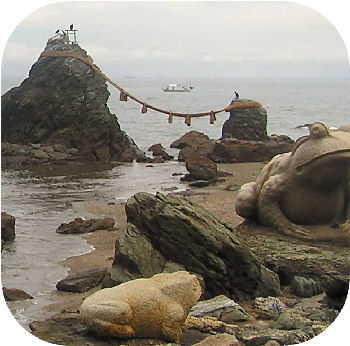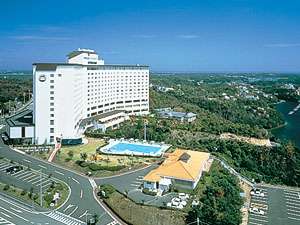|
 |
|
|
|
|
 |
|
Meotoiwa Rocks
(Wedded Rocks) |
|
In the old days, this was a purification place while visiting Ise Grand
Shrine.
The above two Meotoiwa Rocks are small rocky stacks in the sea off Futami
Bay. They are joined by a shimenawa (a heavy rope of rice straw) and are
considered sacred by worshippers at the neighboring Futami Okitama Shrine
(Futami Okitama Jinja). The rocks celebrate the union in marriage. The
rope, which weighs over a ton, must be replaced several times a year in
a special ceremony. The larger rock, said to be male, has a small torii
at its peak. |
|
| Club Tourism Guide Book and Wikipedia |
|
|
|
9. Futami Bay
August 29 |
|
We stayed at Ise Shima Royal Hotel the previous night. It was the pride
of the travel agency. Indeed the guest room, the view over the sea, a big
bath room and an open-air bath, dinner and breakfast, ..... I admitted
it was a very nice hotel and a little bit too good.
The dish "tekone-zushi of bonito" was so delicious. It was the
specialty around this area, so that the lunch at some restaurant near Ise
Shrine the next day was the same name. But the taste was no comparison.

|
|
We left the hotel at 9:00 for Futami Bay. Thanks to the rain last night,
it became cool. It looked going to rain today, too. But no rain, fortunately
or not.
There would be nobody who didn't know Meoto Rocks, but who did know this
place was in Futami Okitama Shrine and also the origin of Futami Frog?
Please allow me to skip the explanation of these for now. |
|
|
|
|
| We dropped in at a pearl center on the way to Ise Grand Shrine. Emiko seemed
to buy something to our daughters.
|
|
| Most Japanese people are familier with "Oku no Hosomichi" (Narrow Road to the Deep North), a major travelogue combining prose and haiku by Matsuo Basho, a great
poet in the late 17th century of Edo period.
Poet Basho left his thatched hut at Fukagawa, Edo (presently Tokyo), in
spring 1689. He walked up to Hiraizumi of northern Japan, then visited
Yamadera (Mountain Temple), Dewa Three Mountains, etc. and saw the Japan
Sea at Sakata, the mouth of Mogami River.
The return travel was from Akita to Ohgaki, Gifu Pref., via Yamagata, Niigata,
Toyama and Fukui prefectures.
At the last place Ogaki in the note, he finished writing as follows.
--- I reached Ogaki, sitting astride a horse. Sora (his follower) from
Ise and Etsujin riding a horse joined me, and then all of us got together
at Joko's home.
--- Though my fatigue did not still disappear after a long journey, I
decided to visit the Regular Shrine Removal of Ise Grand Shrine. I wrote
the following haiku, just starting off on a boat. |
蛤(はまぐり)のふたみにわかれ行く秋ぞ
Hamaguri no Futami ni Wakareyuku Akizo |
Like a clam torn from its shell,
I am going toward Futami of Ise.
It is late in autumn, which makes me
feel more deeply moved by loneliness. |
|
In the year 1689, the completion festival of the Regular Shrine Removal
was done at Ise Grand Shrine. It had been held every 21 years. The festival
of Inner Shrine was planned on September 10, and the one of Outer Shrine
on 13.
Basho strongly wished to pray to the both shrines, and so he left Ogaki with Sora and Rotsu in a hurry.
However, they reached Ise Grand Shrine on the day of 12th, so that they
were not in time for the Inner Shrine Removal, as he regretfully said,
"It was unlucky for us to pray only to the Outer Shrine." |
|
尊さに皆おしあひぬ御遷宮 (芭蕉)
Toutosa ni Mina Oshiainu Gosengu (Basho) |
What a noble atmosphere!
Crowds are pressing together tightly,
here in the Regular Shrine Removal. |
|
|
| Our visit to Ise Grand Shrine is written in the next chapter. |
|
| Part 9 Reading: 7' 12" |
|
|
|
|
|
|
|
|
| Mail |
|
|
|